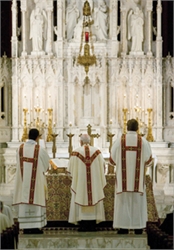
Biskop Edward Slattery fortsetter sin artikkel med følgende argumenter:
Facing the same direction
From ancient times, the position of the priest and the people reflected this understanding of the Mass, since the people prayed, standing or kneeling, in the place which visibly represented Our Lord’s Body, while the priest at the altar stood at the head as the Head. … celebrant and congregation faced the same direction, since they were united with Christ in offering to the Father Christ’s unique, unrepeatable and acceptable Sacrifice. …
Multiple advantages
Having the priest and people celebrate Mass ad orientem was the liturgical norm for nearly 18 centuries. There must have been solid reasons for the Church to have held on to this posture for so long. And indeed there were! First of all, the Catholic liturgy has always maintained a marvelous adherence to the Apostolic Tradition. We see the Mass, indeed the whole liturgical expression of the Church’s life, as something which we have received from the Apostles and which we in turn are expected to hand on intact.
Secondly, the Church held on to this single eastward position because of the sublime way it reveals the nature of the Mass. Even someone unfamiliar with the Mass who reflected upon the celebrant and the faithful being oriented in the same direction would recognize that the priest stands at the head of the people, sharing in one and the same action, which was — he would note with a moment’s longer reflection — an act of worship.
An innovation with unforeseen consequences
In the past 40 years, however, this shared orientation was lost; now the priest and the people have become accustomed to facing in opposite directions. The priest faces the people while the people face the priest, even though the Eucharistic Prayer is directed to the Father and not to the people. …
… Unfortunately this change had a number of unforeseen and largely negative effects. First of all, it was a serious rupture with the Church’s ancient tradition. Secondly, it can give the appearance that the priest and the people were engaged in a conversation about God, rather than the worship of God. Thirdly, it places an inordinate importance on the personality of the celebrant by placing him on a kind of liturgical stage. …
